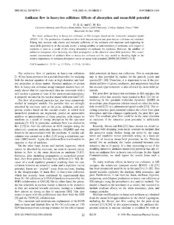| dc.creator | Li, GQ | |
| dc.creator | Ko, Che Ming. | |
| dc.date.accessioned | 2011-09-13T21:27:49Z | |
| dc.date.available | 2011-09-13T21:27:49Z | |
| dc.date.issued | 1996 | |
| dc.identifier.citation | G. Q. Li and Che Ming Ko. Phys.Rev.C 54 R2159-R2162 1996. "Copyright (1996) by the American Physical Society." | en |
| dc.identifier.uri | http://dx.doi.org/10.1103/PhysRevC.54.R2159 | |
| dc.identifier.uri | https://hdl.handle.net/1969.1/126866 | |
| dc.description | Journals published by the American Physical Society can be found at http://publish.aps.org/ | en |
| dc.description.abstract | We study antikaon flow in heavy-ion collisions at SIS energies based on the relativistic transport model (RVUU 1.0). The production of antikaons from both baryon-baryon and pion-baryon collisions are included. Taking into account only elastic and inelastic collisions of the antikaon with nucleons and neglecting its mean-field potential as in the cascade model, a strong antiflow or anticorrelation of antikaons with respect to nucleons is seen as a result of the strong absorption of antikaons by nucleons. However, the antiflow of antikaons disappears after including also their propagation in the attractive mean-field potential. The experimental measurement of antikaon flow in heavy-ion collision will be very useful in shedding light on the relative importance of antikaon absorption versus its mean-field potential. | en |
| dc.language.iso | en | |
| dc.publisher | American Physical Society | |
| dc.subject | NUCLEUS-NUCLEUS COLLISIONS | en |
| dc.subject | SUBTHRESHOLD KAON PRODUCTION | en |
| dc.subject | UEHLING-UHLENBECK MODEL | en |
| dc.subject | ANTIPROTON PRODUCTION | en |
| dc.subject | EQUATION | en |
| dc.subject | GEV/NUCLEON | en |
| dc.subject | EMISSION | en |
| dc.subject | MATTER | en |
| dc.subject | ATOMS | en |
| dc.subject | Physics | en |
| dc.title | Antikaon flow in heavy-ion collisions: Effects of absorption and mean-field potential | en |
| dc.type | Article | en |
| local.department | Physics and Astronomy | en |


